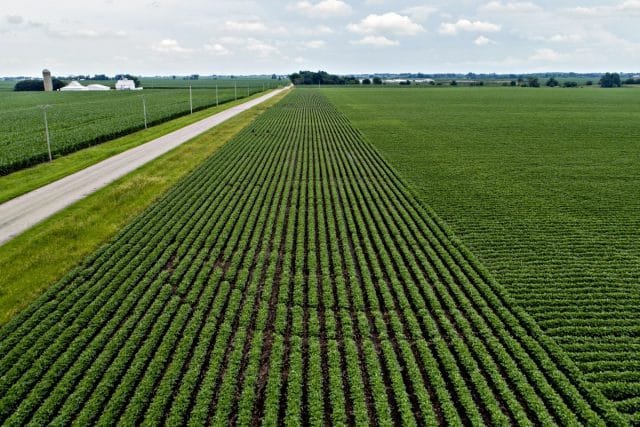by Jim W. Dean, VT Editor, …with New Eastern Outlook, Moscow 1816
“If you really want to make a friend, go to someone’s house and eat with him… the people who give you their food give you their heart.” – César Chávez
[ Editor’s Note: During the geopolitical controversies going on, a lot of names have been used as tags for its major features, “Make America great again”, “Keep America safe”, Russian election interference”, “Spreading freedom and democracy”, “Standing by Israel”, etc., the spinmeisters have done the best they could to construct buttons to push to manipulate public emotions.
But there are terms they have left out, like a new name that I have been saving, “USS, the United States of Sanctions”, and this one for today, “Unipolar World War”. I don’t think the deep-state folks will like the last one, as it focuses attention on something they don’t want us to focus on.
VT readers will have noticed that little feature article writing has been done by corporate media on the possible long term effects that the current USS, Trump, NeoCon and Deep State-driven unipolarism is going to have on the world.
It is presented as a good thing, that all “good” people should support, and only “bad” people would not. Nevertheless, it is just a slick charade for economically and militarily colonizing the world, turning it into one huge plantation for the Deep State boys.
The proof is obvious, as most of those targeted are hunkering down not just to survive a trade-war skirmish involving the US, but for a long term economic war, with the military club always available for closing the deal when needed. I chose this China food security topic as a classic example of a geopolitical shift which will not be easy for the US to undo.
US food imports by China have been a help in balancing its own export trade with the US. Now that sanctions have been weaponized, China, like Russia did when sanctioned after the Ukraine coup, is now making a huge investment to be self-sufficient in feeding its 1.4 billion people.
Once this huge investment is made, US farmers might lose their export market share to China permanently. Once China shows itself as the more efficient food producer, it can work with other unipolar “targeted countries” in its Silk Road network to do the same thing.
The EU is suffering from this right now, with France center stage with its huge farmer protests shaking the country, not only for low crop prices due to the loss of Russian exports, but also the growing number of farmer suicides in France.
And yet the main focus of the Russophobic EU is that its sanctions on Russia will remain for “taking Crimea”, when all Russia did was save the Crimean ethnic Russian population from being savaged by the NATO-supported neo-Nazis in Kiev.
Dear EU and NATO, You are guilty of creating a situation where your little anti-Russian war gaming caper blew up in your faces and your economies are suffering for it. Rather than admitting your mistake, resigning, and letting new people come in to fix the mess, you have labored to hang on to your own power by blaming the whole thing on Russia.
The US has done the same with its China sanctions; and China has responded not with short term measures, but with permanent solutions so the Chinese have more strategic control over their country’s future… JD ]
 Jim's Editor’s Notes are solely crowdfunded via PayPal
Jim's Editor’s Notes are solely crowdfunded via PayPal
Jim's work includes research, field trips, Heritage TV Legacy archiving & more. Thanks for helping. Click to donate >>

– First published … October 26, 2019 –
Earlier this year, China announced adding 5 million more hectares to its 42 million already connected farmland and shooting for 60 million hectares by 2022. This is part of China expanding, modernizing and restructuring its agriculture industry from top to bottom for maximum production and efficiency.
With my growing up in a small New England town, the term hectare was a blank for me in terms of size. But I soon figured out that the total area they had targeted for bringing into production was larger than Spain. With 1.4 billion people to feed, I was not surprised to see China wanting to maximize domestic production to reduce dependency on foreign imports.
Why? Well that is because of the wonderful duo of unipolarism and quickdraw sanctions by you know who. The ongoing trade wars with the US, involving all kinds of products, has many countries looking to maximize domestic production of anything and everything they possibly can. The term food security is here to stay.
China has always had limited arable land, much of which I suspected had been over-farmed. It consisted of only 10% of the total land area, as compared to 20% in the continental United States, and most of it was in the eastern third of the country. Large areas of the country were not suitable, due to lack of rain and the short growing season like in the North, versus South China where three rice crops can be cultivated in a season.
China’s winter wheat, 94% of the total crop, comes from the drier North China Plain, where the land is fertile but subject to floods and drought. Efficient water conservation has contributed to increased yields. The northeastern plains produce spring wheat, corn, and even rice. But much of China’s vast northwest and southwest regions are not suited for cultivation.
There were many hurdles to the ambitious cultivation expansion, as both drought and flood resistant farmland were needed. A holistic approach was used, combing new crop varieties and higher mechanization levels.
Because the February announcement had used the term “connected farmland,” that was a strong hint that large areas were being targeted, so my assumption was that these must be major irrigation projects, which was partially correct. It took further research to discover that rain-making technology was going to be the magic key to it all.
If the Chinese are good at anything, it is in doing large integrated projects. With its huge population and educational system, they have a deep science and technical bench to draw on for the needed talent.
The Russians are in a similar situation with a top-drawer education system and their world class technical contenders, even with a smaller population. What they have been able to produce in their defense modernization on a smaller budget has been amazing, but then they don’t have a huge navy and 750+ foreign base structures to support.
Moscow’s response to the EU sanctions was to cut back on farm imports by boosting domestic food production, and then increasing non-dollar trade with China to be less dependent on the West for basic import needs
Over 40 percent of its arable lands have been overused, with two thirds of that consisting of medium to low yield fields, and half of those lack irrigation. You cannot move land to water, so you have to move water to land, and China chose weather modification, starting with the Tibetan Plateau project in 2013.
Tens of thousands of fuel-burning chambers were set up in the Tibetan mountains, and that boosted rainfall by roughly 10-billion cubic meters annually. The current plan, called Sky River, developed in 2016 at Tsinghua University, attempts to bring rain to an area three times larger than Spain.
According to South China Morning Post in March of 2018:
“The chambers burn solid fuel to produce silver iodide, a cloud-seeding agent with a crystalline structure much like ice. The chambers stand on steep mountain ridges facing the moist monsoon from south Asia. As wind hits the mountain, it produces an upward draft and sweeps the particles into the clouds to induce rain and snow.”
China plans to increase the 10 billion cubic meters of rainfall in the north to 45 billion annually, about 7% of the entire water used by the country. Nowhere in the West have any development projects this size been attempted, and if they were, the cost would have been much higher.
Weather modification has been going on in the US for decades, after being perfected in the Vietnam war. Sadly, wars have often been used for testing such things on live subjects that are not one’s citizens. The concerns for its misuse here led to the US signing the UN Environmental Modification Treaty, prohibiting military or any other hostile use (New York, December 10, 1976).
The Great Leap Forward
China’s huge achievements were based on years of events, starting with the Great Leap Forward, from 1958 to 1960. Agricultural development evolved through the early and painful land reforms, mutual aid teams, cooperatives, and on to collectivization.
Then came the larger people’s communes, 5400 households with between 20,000 to 30,000 members. The peasants suffered under continued pressure to produce more. Production statistics were inflated to keep communist bosses happy, which led to shortages and even declines in production.
Millions of Chinese were starving in the countryside due to government requisitions to feed the large city populations that were considered a more dangerous revolutionary threat. By 1962, China admitted defeat and was importing grain, despite being a net exporter in the 1950’s.
China’s leadership recognized the need to strengthen the agricultural sector via incentives for individual and collective production, expanded private plots and markets. Chemical fertilizer production and imports increased, along with high yielding seed varieties and investments in irrigation.
Farmers were treated more fairly, under an incentive plan where they could keep or sell any excess production, and were given flexibility to put profits into expansion of small business services in rural areas. Gross agricultural output nearly doubled from 1978 to 1985, with per capita peasant income tripling.
Economic cooperatives expanded into manufacturing, mining, transportation, construction and services. China was on the road for its people developing their full potential. Who in China could have ever envisioned in its early days what China has now become? And the same can be said for the old Soviets.
It was not an easy journey for either constituencies, with much suffering and even tragedy, as life is not fair to all. Both Russia and China find themselves in trade battles with a bankrupt US, with its systemic imbalance of trade, looking to gobble up whoever it can to stay afloat.
While both countries want to be open trade partners with the world, they also see they must be as self-reliant for as much of their needs as possible. While they have watched deficit funding and national debt balloon in the West, both have protected themselves from a crash in the West via large foreign reserve accounts and by increasing gold reserves.
Back in the US, Fort Knox gold has not been audited since anyone can remember, and families worry about what may be coming for their children and grandchildren, besides college debt they can never repay and white collar jobs at blue-collar wages, or even lower.
I fear food is going to be the next nuclear weapon in the next big war, or I should say, the denial of food. There is already a history for it. During the Cold War, we were fortunate to not have the nukes used, but everything else was, including weaponizing food.
Wheat rust was used against both the Soviet and Chinese wheat crops. Scientists were routinely working on food diseases and pandemics to inflict on an enemy population.
NEO’s Henry Kamens has written for years on how the US has worked in the ‘stan’ countries in their biological labs to do testing against the law in the West. In Georgia, lab workers got sick and some died from biological weapons work that was supervised by US contractors. Henry reported this at great risk.
Genetic editing is now all the rage, and you can bet more government money is being spent on using gene technology to kill people that on saving lives. The Deep State crowd is into saving the world ecosystem by depopulating it significantly in the next big war.
China knows the US has been doing food war research, part of which entails having seed strains that are resistant to what would be used against an “enemy” crop that got out of hand and traveled back to its maker. A crop destroyer cannot be deployed without having a new seed strain that is protected.
One of China’s big Intel goals in the US is trying to stay on top of US research in this regard. One of the oddest anomalies of the New Cold War is Michigan State in East Lansing, Michigan, where 12% of the population are Chinese students, many are studying in its highly rated agricultural school.
So yes, China is planning ahead and putting significant resources into defending on fronts where it has already been attacked in the past. The recurrent swine flu problems there should have people thinking more about who is really behind them. Beside trade wars, and Uni-polarism wars, are biological food and husbandry wars already in progress?
Jim W. Dean, managing editor for VT, producer/host of Heritage TV Atlanta, specially for the online magazine “New Eastern Outlook”.

Jim W. Dean is VT Editor Emeritus. He was an active editor on VT from 2010-2022. He was involved in operations, development, and writing, plus an active schedule of TV and radio interviews. He now writes and posts periodically for VT.
ATTENTION READERS
We See The World From All Sides and Want YOU To Be Fully InformedIn fact, intentional disinformation is a disgraceful scourge in media today. So to assuage any possible errant incorrect information posted herein, we strongly encourage you to seek corroboration from other non-VT sources before forming an educated opinion.
About VT - Policies & Disclosures - Comment Policy




Thanks for the Round-up note. I did not know. This biological warfare problem will continue as a lot of this diseases have been with us for a while, like swine flu, so they are a good screen behind which nasty things can be done. We got onto this history when we broke the Lugar Lab story in Georgia doing testing banned in the US, where it was already having control problems and injuries.
Mr. Dean, You have provided us with an excellent primer for the annihilation of humanity by it’s own hand.
…..China is also leasing thousands of hectares of land in Siberia across the river border with Russia. But every since Monsanto’s patent on round-up expired, China is now the number one producer of round-up. Don’t know if they are selling it to America or using it themselves. Either way, killing all the bugs and micro-organisms in the soil may be our undoing. But until then we will be eating high on the hog. Scratch that, swine flu has already killed a quarter of the worlds hogs. Food chains are a precarious situation……
Comments are closed.